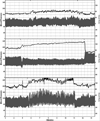Postural tachycardia syndrome (POTS)
- PMID: 19207771
- PMCID: PMC3904426
- DOI: 10.1111/j.1540-8167.2008.01407.x
Postural tachycardia syndrome (POTS)
Abstract
Introduction: POTS is defined as the development of orthostatic symptoms associated with a heart rate (HR) increment >or=30, usually to >or=120 bpm without orthostatic hypotension. Symptoms of orthostatic intolerance are those due to brain hypoperfusion and those due to sympathetic overaction.
Methods: We provide a review of POTS based primarily on work from the Mayo Clinic.
Results: Females predominate over males by 5:1. Mean age of onset in adults is about 30 years and most patients are between the ages of 20-40 years. Pathophysiologic mechanisms (not mutually exclusive) include peripheral denervation, hypovolemia, venous pooling, beta-receptor supersensitivity, psychologic mechanisms, and presumed impairment of brain stem regulation. Prolonged deconditioning may also interact with these mechanisms to exacerbate symptoms. The evaluation of POTS requires a focused history and examination, followed by tests that should include HUT, some estimation of volume status and preferably some evaluation of peripheral denervation and hyperadrenergic state. All patients with POTS require a high salt diet, copious fluids, and postural training. Many require beta-receptor antagonists in small doses and low-dose vasoconstrictors. Somatic hypervigilance and psychologic factors are involved in a significant proportion of patients.
Conclusions: POTS is heterogeneous in presentation and mechanisms. Major mechanisms are denervation, hypovolemia, deconditioning, and hyperadrenergic state. Most patients can benefit from a pathophysiologically based regimen of management.
Figures

References
-
- Low PA, Opfer-Gehrking TL, Textor SC, Benarroch EE, Shen WK, Schondorf R, Suarez GA, Rummans TA. Postural tachycardia syndrome (POTS) Neurology. 1995;45:S19–S25. - PubMed
-
- Streeten DH, Anderson GH, Jr, Richardson R, Thomas FD. Abnormal orthostatic changes in blood pressure and heart rate in subjects with intact sympathetic nervous function: Evidence for excessive venous pooling. J Lab Clin Med. 1988;111:326–335. - PubMed
-
- Fouad FM, Tadena Thome L, Bravo EL, Tarazi RC. Idiopathic hypovolemia. Ann Intern Med. 1986;104:298–303. - PubMed
-
- Hoeldtke RD, Dworkin GE, Gaspar SR, Israel BC. Sympathotonic orthostatic hypotension: A report of four cases. Neurology. 1989;39:34–40. - PubMed
-
- Coghlan HC, Phares P, Cowley M, Copley D, James TN. Dysautonomia in mitral valve prolapse. Am J Med. 1979;67:236–244. - PubMed
Publication types
MeSH terms
Grants and funding
LinkOut - more resources
Full Text Sources
Other Literature Sources

